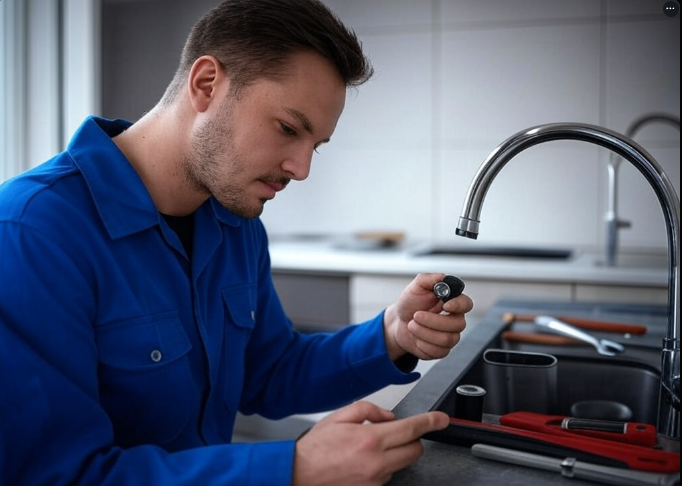Plumbing problems are something every Aussie homeowner faces at some point. From a dripping tap to a blocked drain, these issues can pop up when you least expect them and − if left untreated − they can lead to bigger (and more expensive) problems down the track.
However, most plumbing issues are easy to spot if you know what to look for. In this blog, we’ll walk you through the five most common household plumbing problems across Australia.
We’ll explain what causes common bathroom plumbing problems, the signs to watch out for, and when it’s time to call in a professional. Whether you’re dealing with a small annoyance or something a bit more serious, this guide will help you stay on top of your home’s plumbing and avoid any nasty surprises.
1. Leaky Taps and Fixtures
Leaky taps might seem like a small annoyance, but they can waste a surprising amount of water over time − and drive your water bill up. Here’s what you need to know:
- Common causes: Worn-out washers, damaged O-rings, or corroded valve seats are often to blame.
- Drip, drip, drip: Even a slow drip can waste thousands of litres each year.
- Annoying noises: The constant sound of dripping can be frustrating, especially at night.
- DIY fix? Replacing a washer or O-ring is usually a simple job if you’re comfortable with basic tools.
- Signs of bigger issues: Persistent leaks could point to pipe corrosion or water pressure problems.
- Don’t ignore it: A small leak can turn into a bigger plumbing issue if left unchecked.
- When to call a plumber: If you’ve tried fixing it and it’s still leaking, or if multiple taps are affected, it’s time to get professional help.
2. Blocked Drains
Blocked drains are a common plumbing headache in many Aussie homes. They can start off as a slow drain but quickly turn into a smelly, messy problem. Here’s what to watch for:
- Common causes: Hair, grease, food scraps, soap scum and even tree roots can clog your pipes.
- Warning signs: Water draining slowly, bad smells, gurgling sounds, or water backing up in sinks and showers.
- DIY tricks: Try a plunger, drain snake, or a mix of baking soda and vinegar for minor clogs.
- Avoid chemical cleaners: They can damage your pipes over time and aren’t great for the environment.
- Prevention tips: Use drain strainers, avoid pouring grease down the sink, and regularly flush drains with hot water.
- When to call a pro: If the blockage keeps coming back or affects multiple drains, it’s time to bring in a plumber with the right tools.
3. Running Toilets
A constantly running toilet might not seem like a big deal at first, but it can waste hundreds of litres of water a day − and that quickly adds up on your water bill.
In most cases, a running toilet is caused by a faulty flapper valve, which is the rubber part inside the cistern that controls the flow of water to the bowl. If it’s worn out or not sealing properly, water will continue to run.
Other possible culprits include a broken float, loose fill tube, or an issue with the flush handle. The good news is that these parts are usually cheap and easy to replace.
If you’re confident with basic DIY, you might be able to fix it yourself. But if the problem persists or you’re unsure where to start, it’s best to get a plumber in. A quick fix now can save you money and hassle later.
4. Low Water Pressure
Struggling with weak showers or slow-filling sinks? Low water pressure is a frustrating issue that many Australian households face.
Here’s what could be behind it:
- Build-up in pipes: Mineral deposits or rust can narrow your pipes, restricting water flow.
- Leaky pipes: Hidden leaks in your plumbing system can reduce overall pressure.
- Faulty fixtures: Blocked or worn-out taps and showerheads might be the culprits.
- Water supply issues: Sometimes the problem is with the local water supply or council maintenance work.
- Pressure regulator problems: If your home has a pressure-reducing valve, it may need adjustment or replacement.
- Signs to look for: Uneven pressure in different areas of the house or a sudden drop in flow.
- What to do: Clean your fixtures, check for visible leaks, and if that doesn’t help, get a plumber in to inspect the system properly.
Don’t settle for a trickle − get it checked.
5. Hot Water System Problems
There’s nothing worse than jumping into the shower only to find there’s no hot water. Hot water system issues are one of the most common plumbing problems in Australian homes.
Whether it’s a complete lack of hot water, fluctuating temperatures, strange noises or a leaking tank, these problems can really disrupt your day. The cause could be anything from a faulty thermostat or heating element to sediment build-up in the tank or even a broken pressure relief valve.
Older systems are more prone to issues, especially if they haven’t had regular maintenance. If your hot water is running out too quickly or smells metallic, it’s a sign your system might need some attention.
While minor problems can sometimes be fixed with a simple part replacement, more serious issues could mean it’s time for a new unit. This means you could consider an eco-friendly solution such as a solar hot water system or a heat pump unit.
Either way, a licensed plumber can diagnose the issue and get your hot water back on track.
When to Call a Professional Plumber
While some minor plumbing issues can be handled with a bit of DIY, others really need a licensed expert. Knowing when to call in a professional can save you time, stress, and costly damage.
Here’s when it’s best to pick up the phone:
- Recurring problems: If a leak, blockage, or pressure issue keeps coming back, it needs expert attention.
- No hot water: This often signals a problem with your hot water system that a plumber should diagnose.
- Burst pipes or major leaks: These are emergencies − turn off the water and call a plumber immediately.
- Sewage smells or backflow: These issues are serious health hazards and need urgent professional help.
- Renovations or new installations: Always use a licensed plumber for bathroom or kitchen upgrades.
- You’re unsure what to do: If you’re scratching your head or second-guessing your fix, it’s safer to leave it to the pros.
Stay on Top of Plumbing Problems
Plumbing problems are something every homeowner deals with eventually, but the key is knowing how to spot them early and take action before they turn into bigger issues.
Whether it’s a leaky tap, blocked drain, running toilet, low water pressure or hot water trouble, these common plumbing problems can usually be fixed quickly with the right approach. Some can be handled with a bit of DIY know-how, while others are best left to the professionals.
Regular maintenance and keeping an eye out for warning signs can save you money, water and stress down the track. If you’re ever in doubt, don’t hesitate to call a licensed plumber − they’ve got the tools and experience to get the job done right.
Staying on top of your plumbing is one of the simplest ways to keep your home running smoothly.

